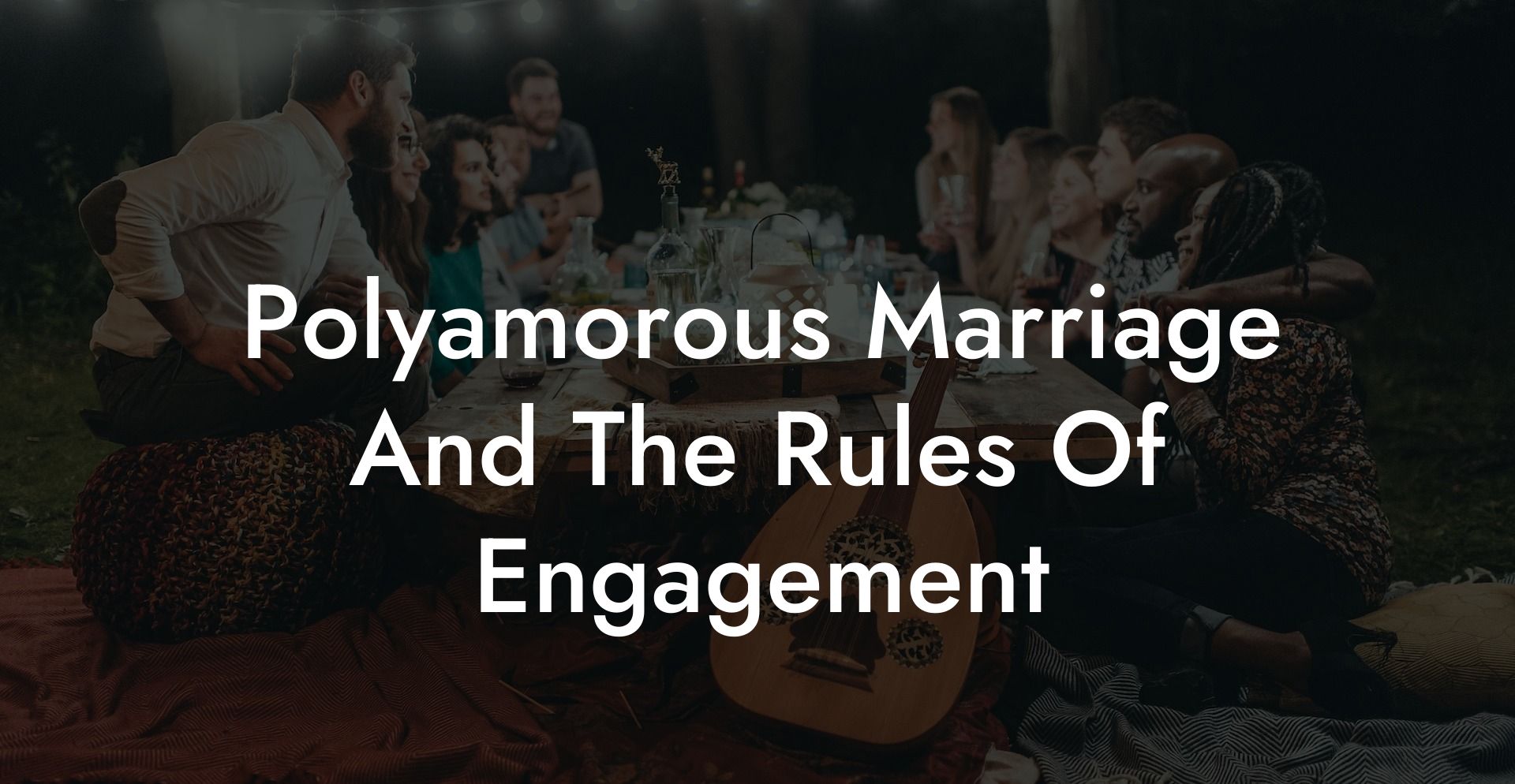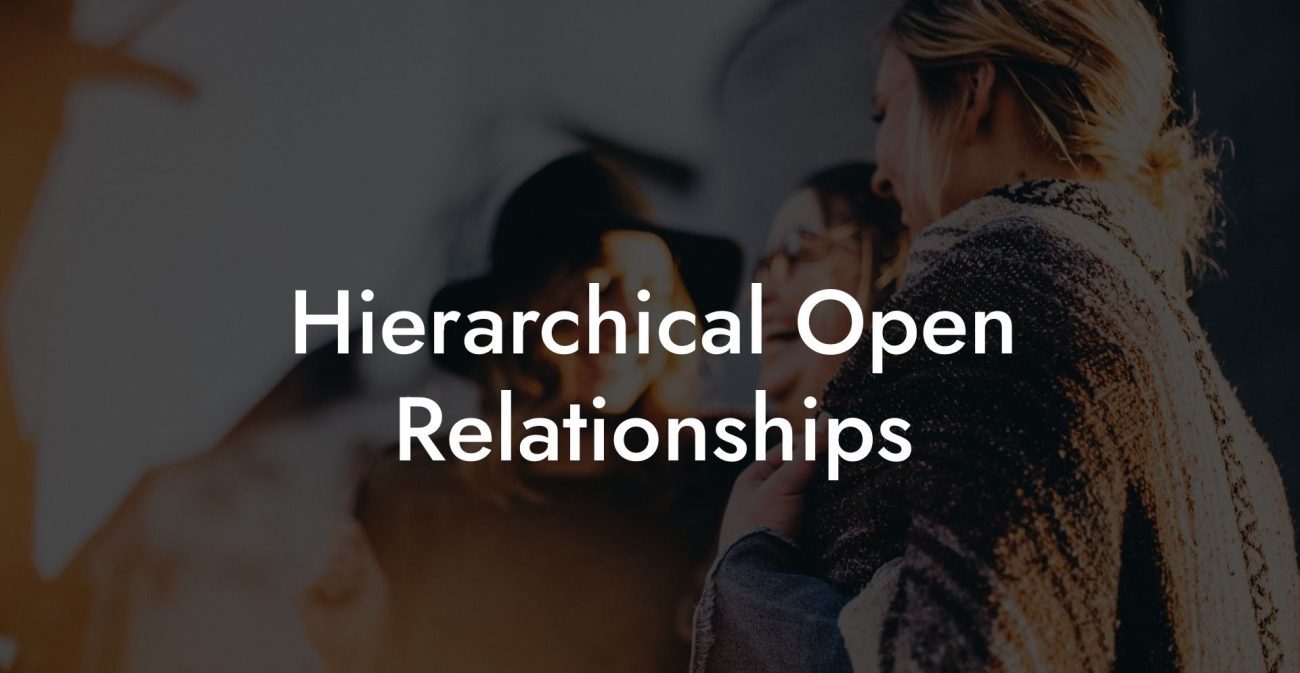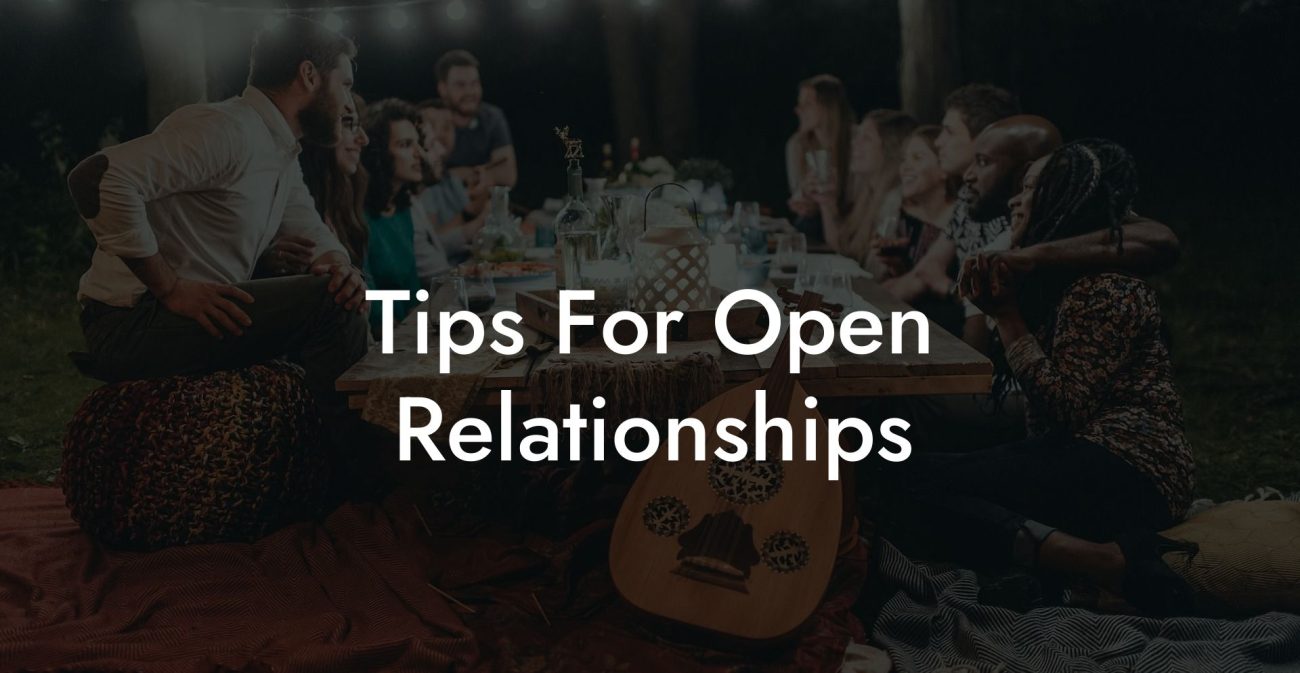Guide to Polyamorous Marriage And The Rules Of Engagement

Imagine a world where the rules of engagement in love are rewritten by rebels of romance, a place where marriage is not a rigid contract, but a living, breathing work of art crafted by those bold enough to defy conventional norms. Picture a polyamorous marriage that isn’t just about adding more names to the family tree, but about creating a vibrant tapestry of deep emotional bonds, where every connection is celebrated and every rule is a stepping stone to greater intimacy. This is the realm of polyamorous marriage and the rules of engagement, a daring exploration into how couples can navigate multiple loving relationships with open hearts, strategic communication, and a commitment to ethical non-monogamy.
Quick Links to Useful Sections
- Understanding Polyamorous Marriage and Its Rules of Engagement
- What Is Polyamorous Marriage?
- The Philosophy Behind Polyamorous Marriage
- Embracing Abundance and Freedom
- The Core Values: Consent, Transparency, and Mutual Respect
- The Rules of Engagement in a Polyamorous Marriage
- Establishing Clear Communication Protocols
- Setting Boundaries That Evolve
- Consent and Continuous Affirmation
- Emotional Self-Awareness and Conflict Resolution
- Benefits of Polyamorous Marriage and Clear Engagement Rules
- Diverse Emotional Support and Stability
- Enhanced Communication and Conflict Resolution Skills
- Flexibility and Personal Growth
- A Supportive Community and Inclusive Network
- Challenges and How to Overcome Them
- Managing Jealousy and Insecurity
- Balancing Time and Energy
- Negotiating Evolving Boundaries
- Dealing with Social Stigma and External Pressures
- Expert Insights on Polyamorous Marriage and Engagement Rules
- FAQ: Your Polyamorous Marriage and Rules of Engagement Questions Answered
Understanding Polyamorous Marriage and Its Rules of Engagement
What Is Polyamorous Marriage?
Polyamorous marriage is a consensual relationship model where individuals form long-term, committed bonds with more than one partner. Unlike traditional monogamous marriage, polyamorous unions thrive on the belief that love is an inexhaustible resource, one that expands and evolves with each new, mutually consensual connection. In these marriages, all partners are aware of each other’s existence, and communication, trust, and transparency form the bedrock of every interaction.
The rules of engagement in a polyamorous marriage refer to the guidelines and boundaries that all participants agree upon to ensure that each relationship is nurtured with respect, consent, and honesty. These “rules” are not about control or restriction; they are about creating a framework that supports growth, minimizes conflict, and fosters deep emotional fulfillment.
The Philosophy Behind Polyamorous Marriage
Embracing Abundance and Freedom
At its core, polyamorous marriage challenges the conventional notion that love is limited to one person. It is built on the philosophy that emotional and romantic energy is abundant and that each connection, no matter how varied, can enhance your life. This mindset encourages individuals to reject the idea of “one true love” in favor of a broader, more inclusive understanding of intimacy. The polyamorous approach invites you to redefine what it means to be committed by embracing the beauty of diverse emotional experiences.
Rather than seeing multiple relationships as competing for your love and attention, polyamory views them as complementary, each partner contributes a unique perspective and strength to your shared life. This is not merely a juggling act; it is a creative process that, when managed with care, leads to a richer, more fulfilling existence.
The Core Values: Consent, Transparency, and Mutual Respect
The success of any polyamorous marriage hinges on a few non-negotiable values:
- Free and Informed Consent: Every relationship begins and continues with the enthusiastic consent of all parties. Consent is ongoing, requiring regular reaffirmation as feelings and circumstances change.
- Transparency: Honesty in communication is critical. All partners need to be open about their desires, boundaries, and any changes in their emotional landscape. Transparency builds trust, which is essential for navigating the complexities of multiple relationships.
- Mutual Respect: Each partner’s needs and contributions are valued equally. This respect ensures that, even if one connection is more central than others, every relationship is treated with dignity and care.
- Flexibility: Relationships evolve, and so must the rules. Being open to renegotiating boundaries and adapting to new circumstances is vital for the long-term success of polyamorous marriages.
- Emotional Accountability: Self-reflection and taking responsibility for your emotions play a key role in managing jealousy and insecurity, ensuring that you contribute positively to the relationship network.
The Rules of Engagement in a Polyamorous Marriage
Establishing Clear Communication Protocols
Communication is the lifeblood of any relationship, but in a polyamorous marriage, it becomes absolutely critical. The rules of engagement start with establishing protocols for how and when to communicate. This might include:
- Regular Check-Ins: Set up weekly or monthly meetings (either as a group or individually) to discuss feelings, expectations, and any adjustments needed.
- Use “I” Statements: Frame your concerns and emotions by speaking from your perspective, “I feel…” rather than “You make me feel…”, to foster a non-confrontational dialogue.
- Designated Communication Channels: Utilize tools such as shared calendars, group chats, or dedicated relationship apps (like Notion or Trello) to keep everyone informed and on the same page.
Setting Boundaries That Evolve
Boundaries are not fixed; they are living guidelines that adapt as relationships grow and change. The rules of engagement should include:
- Defining Personal Space: Clarify how much time each partner needs alone and with the central couple. This might mean designating “alone time” as well as “group time.”
- Physical and Emotional Boundaries: Discuss what types of interactions are comfortable for all involved, this includes expectations around sexual activity, emotional sharing, and public versus private interactions.
- Revisiting Agreements Regularly: Set a schedule for reviewing and updating boundaries. What worked last month might need adjustment as personal needs and life circumstances change.
Consent and Continuous Affirmation
Consent is the cornerstone of polyamorous engagement. It’s not enough to obtain consent once, each partner must continually reaffirm their agreement to the current structure and any changes that occur. This ongoing process involves:
- Open Discussions: Ensure that consent is revisited during every check-in, especially when introducing new partners or changing existing relationship dynamics.
- Transparency in Intentions: Every new experience should be discussed openly, so that all partners have the opportunity to voice their thoughts and concerns.
- Respecting Decisions: If a partner withdraws consent or expresses discomfort, it must be respected without pressure or judgment.
Emotional Self-Awareness and Conflict Resolution
Emotions can run high in polyamorous marriages, making self-awareness and conflict resolution essential parts of the rules of engagement. Strategies to foster emotional well-being include:
- Journaling and Reflection: Encourage all partners to maintain a journal or engage in reflective practices to understand their emotions and triggers.
- Conflict Resolution Techniques: Learn and practice methods such as active listening, mediation, and empathy-building exercises to resolve disagreements constructively.
- Professional Support: Consider regular therapy sessions, individually or as a group, to help navigate particularly challenging periods.
Benefits of Polyamorous Marriage and Clear Engagement Rules
Diverse Emotional Support and Stability
One of the primary benefits of a polyamorous marriage is the diversity of emotional support available. A well-structured polyamorous relationship allows you to draw on the strengths of each partner, creating a resilient, multifaceted support network. The rules of engagement help maintain this balance, ensuring that every relationship contributes positively to your overall well-being.
Enhanced Communication and Conflict Resolution Skills
By prioritizing regular, structured communication, you develop skills that not only strengthen your relationships but also improve your overall ability to navigate complex emotional landscapes. The emphasis on conflict resolution fosters a culture of understanding and continuous improvement.
Flexibility and Personal Growth
The adaptability inherent in polyamorous marriages encourages ongoing personal growth. As you regularly revisit your boundaries and negotiate new terms, you learn more about your own needs and develop greater emotional resilience. This flexibility allows the relationship to evolve naturally, accommodating life changes and personal development.
A Supportive Community and Inclusive Network
Many polyamorous couples find that having clearly defined rules of engagement helps them build a supportive, inclusive network. By openly communicating and sharing experiences, you not only strengthen your own relationship but also contribute to a broader culture of ethical non-monogamy.
Challenges and How to Overcome Them
Managing Jealousy and Insecurity
Even with the best-laid rules, feelings of jealousy and insecurity can still surface. These emotions are natural responses to perceived threats to your central connection. Overcoming these challenges involves:
- Engaging in regular, honest conversations to understand the roots of these feelings.
- Practicing self-reflection and mindfulness to manage your emotional responses.
- Seeking support from trusted friends, community groups, or professional therapists when needed.
Balancing Time and Energy
One of the most practical challenges in a polyamorous marriage is managing your time and energy effectively. With multiple relationships vying for your attention, it’s easy to feel overwhelmed or neglect one connection in favor of another. Overcoming this challenge requires:
- Using digital tools like shared calendars and scheduling apps to coordinate time effectively.
- Prioritizing quality time with each partner based on mutual agreements.
- Regularly reassessing your schedule and making adjustments to ensure balance.
Negotiating Evolving Boundaries
As relationships grow and change, boundaries must be renegotiated, which can be challenging and sometimes emotionally taxing. To manage this:
- Establish a routine for revisiting boundaries, such as quarterly reviews or after major life events.
- Be open to feedback and ready to adjust your expectations as necessary.
- Document agreements in a shared space (digital or written) so that everyone has a clear reference point.
Dealing with Social Stigma and External Pressures
Polyamorous marriages often face misunderstanding and judgment from those outside the lifestyle. This external pressure can create additional stress within the relationship. Strategies to mitigate these challenges include:
- Building and nurturing a supportive community of like-minded individuals who understand your values.
- Educating others about polyamory through conversation and public advocacy, when appropriate.
- Focusing on your own growth and validation, rather than seeking approval from outside sources.
Expert Insights on Polyamorous Marriage and Engagement Rules
Relationship experts agree that the success of a polyamorous marriage hinges on the willingness of all partners to engage in continuous, honest dialogue and to adapt as needed. Dr. Elena Rivera, a therapist specializing in non-traditional relationships, notes, “Polyamorous marriages that emphasize open communication, flexible boundaries, and mutual consent tend to be more resilient and fulfilling. The rules of engagement act as the glue that holds the diverse parts of the relationship together.”
Relationship coach Marcus Lee adds, “It’s essential to view the rules of engagement not as restrictions but as tools for empowerment. When each partner knows what to expect and feels secure, the entire relationship network becomes more robust and dynamic.”
FAQ: Your Polyamorous Marriage and Rules of Engagement Questions Answered
1. What is polyamorous marriage?
Polyamorous marriage is a consensual, long-term relationship model in which individuals form multiple deep emotional and romantic connections, with every relationship maintained through open communication and mutual consent.
2. What are the rules of engagement in a polyamorous marriage?
The rules of engagement are the guidelines and boundaries that all partners agree upon to ensure that each relationship is ethical, respectful, and fulfilling. These include regular communication, flexible boundaries, continuous consent, and mutual respect.
3. How important is communication in polyamorous marriage?
Communication is absolutely critical. Regular, honest dialogue is essential for managing emotions, renegotiating boundaries, and ensuring that all partners feel valued and secure.
4. How can we manage jealousy and insecurity?
Jealousy and insecurity can be managed through open communication, self-reflection, and, if necessary, professional therapy. Addressing these feelings directly helps prevent them from undermining the relationship.
5. What tools can help balance time and energy among multiple partners?
Digital tools like shared calendars, scheduling apps (such as Trello or Notion), and relationship management systems are invaluable for coordinating time and ensuring that every relationship gets the attention it deserves.
6. How do we negotiate evolving boundaries?
Establish a routine for regular check-ins where boundaries can be discussed and adjusted. Document agreements in a shared space and remain flexible as needs change.
7. How can we deal with societal stigma?
Building a supportive network of like-minded individuals and educating those around you about the values of polyamory can help mitigate external pressures and reinforce your commitment to your lifestyle.
8. Can polyamorous marriage lead to long-lasting, fulfilling relationships?
Yes, many couples in polyamorous marriages report deep, lasting connections that are enriched by the diversity of emotional support and the continuous commitment to open communication.
9. What are the main benefits of a polyamorous marriage?
Benefits include diverse emotional fulfillment, personal growth, enhanced communication skills, flexibility in relationship structure, and the creation of a supportive, inclusive community.
10. Where can I find more resources on polyamorous marriage?
Explore books like "The Ethical Slut" and "More Than Two", listen to podcasts such as “Multiamory,” and join online communities on Reddit and Facebook dedicated to polyamory for additional insights and support.
Resources and Community Support: Your Next Steps in Embracing Polyamorous Marriage and the Rules of Engagement
- "The Ethical Slut" by Dossie Easton & Janet Hardy – A groundbreaking exploration of ethical non-monogamy and alternative relationship structures.
- "More Than Two" by Franklin Veaux & Eve Rickert – Provides practical advice, personal narratives, and tools for managing multiple relationships.
- Podcasts: Listen to “Multiamory” and other relationship-focused shows to hear real-life stories and expert insights into polyamorous marriage.
- Online Communities: Engage with polyamory-focused forums and social media groups on platforms like Reddit (e.g., r/polyamory) and Facebook to connect with like-minded individuals.
- Therapy and Counseling: Consider seeking professional guidance from therapists or relationship coaches experienced in non-traditional relationships to support your journey.
With a commitment to open communication, flexible boundaries, and continuous self-reflection, you can build a polyamorous marriage that not only defies traditional norms but also provides a rich, deeply fulfilling foundation for love and connection. Embrace the journey, trust in your collective strength, and let your relationships evolve into a vibrant tapestry of shared experiences and endless possibilities.
Lost & confused by all of the terms, types and seemingly made up 3 letter acronyms?? We've got you. Check out our Ethnical Non-Monogamy Dictionary >>
Useful Interruption: Not sure which relationship vibe fits you best? Take our Relationship Test, it’ll give you the real insight into your natural relationship style. Then, dive into our binge-worthy guides (from the tried-and-true to the “wait, that’s a thing?”) and find the perfect relationship type for your life:
- Monogamy
- Open Relationships
- Ethical Non-Monogamy
- Solo Polyamory
- Non-Hierarchical Polyamory
- Hierarchical Polyamory
- Relationship Anarchy
- Swinging
Now back to the main article but yeah take the test...












